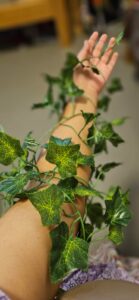Concept:
The idea for creating an unusual switch with my arm actually struck me while I was at the gym. As I was practicing with dumbbells, I thought, “Why not use the motion of my arm to activate a switch?” When I was doing bicep curls — you know, the exercise where you pull the dumbbells up toward your shoulders, maybe called as bicep curls— it clicked. I needed some conductors that could connect the wires and pass electricity when my arm moved upward. I initially thought of using aluminum foil, but that felt too common. I wanted to do something different, so I decided to go with aloe vera gel instead. It seemed like a more unique choice, and I was curious to see how well it would conduct electricity.
Hardware Used:
- Arduino
- LED
- 330 ohm resistor
- Jumper wires
- Breadboard
- Aloe vera gel (as a conductor)
- Aluminum foil (optional, used for wrapping, but didn’t use)
- Glue to attach the aloe vera slices with a decorative plant that can be wrapped around my arm
Process:
- Prepare the Aloe Vera Gel: I first applied some aloe vera gel to the inside of my elbow, creating a path for electricity when my arm bends during the bicep curl motion. This would serve as a conductor, allowing the current to flow when I made contact. But, it did not work. So, I used this decorative plant to wrap my arm and put the aloe vera slices glued on to it.
- Set Up the LED Circuit:
- I placed the LED on the breadboard, with the shorter leg (cathode) on one row and the longer leg (anode) on another.
- I connected a 330 ohm resistor to the same row as the shorter leg of the LED. The other end of the resistor was connected to one of the Arduino’s GND pins.
- Then, I took a jumper wire and connected the row with the longer leg of the LED (anode) to digital pin 13 on the Arduino.
- Integrate the Aloe Vera Gel as the Switch:
- I connected a jumper wire from the Arduino’s 5V pin to one piece of aloe vera that was in contact with my elbow.
- Another jumper wire went from the same piece of aloe vera to pin 2 on the Arduino (set up as an input pin).
- I then placed the second piece of aloe vera on the outer part of my elbow, completing the circuit when my arm was bent.
- Coding the Arduino:
- In the code, I used
digitalRead()to check if there was a connection between the two pieces of aloe vera (when the gel completed the circuit during the bicep curl). - If the circuit was closed, the LED would turn on. When I relaxed my arm, breaking the connection, the LED would turn off.
- In the code, I used
- Testing: I tried different amounts of aloe vera gel and even experimented with wrapping aluminum foil around the gel for better conductivity. Eventually, I found a sweet spot where the gel was conductive enough to switch the LED on and off based on my arm movement.
Pictures From The Process:
The circuit:

 This is the circuit with aloe vera slices and decor plant on my arm.
This is the circuit with aloe vera slices and decor plant on my arm.
Unfortunately, the decor plant did not work properly. So, I used a black rope ( does not look good) to tie aloe vera with my arm directly. Here is the final one!
Video of the switch:
Reflection and Future Implementation:
- Need to find a way to adjust the aloe vera properly on my arm as I tried to use glue on a decor plant which did not work and gave me burning sensation on my elbow area instead.
- Overall, I find it amusing to work with aloe vera and electronics. It was fun!

